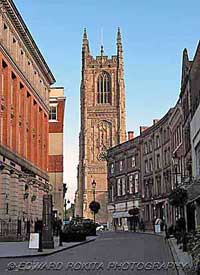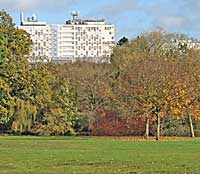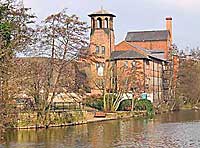Derby City Guide - About Derby
Derby in Derbyshire is the UK's most central city, benefiting from the best of both worlds - a great cultural base situated in the East Midlands on the edge of the Peak District National park.

Elvaston Castle and Gardens in Derby
Derby is famous for setting in motion Britain's Industrial Revolution with some of the countrys first factories and spinning mills. It is equally famous for later factories of Rolls Royce, Royal Crown Derby and Railway engineering. The thriving City centre boasts an excellent range of entertainment venues, attractions, pubs, restaurants, parks and open spaces.
Derby is twinned with Osnabrück in Germany. Every year, Derby and Osnabrück each appoint an Envoy who spends twelve months in his or her twin city.
Derby also has friendship links with Kapurthala in Punjab, India, Haarlem in the Netherlands and Foncquevilliers in France. Derby has also joined Derbyshire County Council and South Derbyshire District Council in a link with Toyota City in Japan and in 2004 Derby signed a Memorandum of Understanding with Changzhi City in China.
Facts
Dialling Code for Derby UK: +44 (0) 1332
Derby's population. In 2014 the population od Derby was 252,500. There were significant changes between 2001 and 2015. Derby's population increased by more than 18,000 people . Derby has seen a large increase in the Polish population here.
Tourist Information: Derby Tourist Office, Assembly Rooms, Market Place, Derby DE1 3AH, tel: +44 (0) 1332 255 802,
Derby City MPs are, Margaret Beckett , Labour, for Derby South and Chris Williamson, Labour, for Derby North
The River Derwent flows north to south-east through Derby. Much of the city centre, which extends south of the river, is pedestrianised. The main thoroughfare runs from the Cathedral at the northern end to a crossroads called 'The Spot' at the southern end, changing its name along the way from Iron Gate (at the Cathedral) to Cornmarket (at the junction with Market Place) and finally to St Peter's Street (at the junction with Victoria Street). East of Iron Gate is Friar Gate, the Georgian area of the city. Northeast of the Cathedral is the Derby Industrial Museum.
Derby City Centre is quite compact with much of the central area a pedestrianised zone making shopping quite easy.
There are a good range of High street stores lining the Victorian buildings of pedestrianised Cornmarket and Victoria Street. Babington Buildings on nearby St Peter's Street houses a large Waterstones bookshop.
Sadler Gate and Iron Gate ( part of Derby Cathedral Quarter ) are lined with 16th-century buildings and boast numerous gift shops, clothes shops, pubs and restaurants.
The INTU centre replaced the former Eagle Centre. Open every day, INTU Derby is an all-weather shopping mall, located off St Peter's Street and London Road .
At the foot of Iron Gate is Market Hall which houses an indoor market (open Mon-Sat) selling clothes, fruit, vegetables, meat, fish and sweets. Enter by passing under the Guildhall clock from Market Place. A farmers' market is held in Market Place on the third Thursday of every month and the section between Albion Street and the bus station is also a vibrant market area where stallholders peddle individual, often handmade wares.
Derby's Cathedral Green has been redeveloped and a swing bridge built over the river derwent
Derby Cityscape is a government-funded body given the task of making Derby city centre a better place to live and visit.
It was created in recognition of the fact that the centre had seen relatively little development over the past few years in comparison to East Midlands rival cities Nottingham and Leicester.
The project brings together a number of partners including Derby City Council and the East Midlands Development Agency who will work with commercial and retail companies in the coming years to bring the plans to life.
Cityscape divides the city into a number of areas with different plans for each:
Castle Ward :
The area between Derby train station and the main centre will be turned into an urban community with bars and cafes, new homes and shops.
The idea is it should be a 'gateway to the city'.
Friar Gate :
Derby's 'business quarter' will see new office developments and a new purpose-built centre to house creative industries.
Civic Quarter/Beckett Well :
The heart of the city centre, including the new Visual Arts and Media Centre, new and upgraded open spaces at Market Place and Cathedral Gardens, apartments on Full Street, a new 4 star hotel and the Riverlights development

Irongate Derby |

Derby University |

Derby Industrial Museum |

Elizabeth Hardwick |
A Grade I listed building identifies outstanding architectural or historic interest in a small proportion of all listed buildings. In Derby there are nine buildings of exceptional interest. They are
St Mary's Bridge Chapel on Bridge Gate, built in the 14th Century
Church of St Mary Church Lane Chaddesden, built in 1357
Church of All Saints ( Derby Cathedral ) Tower built in the 16th Century
County Hall in St Mary's Gate , dating from 1660
St Helen's House on King Street , dating from 1726
Bakewell's Gates at The Silk Mill, dating from 1728
The Homestead with Gatepiers in Sitwell Street Spondon, dating from 1740
Pickfords House in Friar Gate, dating from 1770
Darley Abbey Mills, dating from 1792
There are also 40 buildings listed Grade II* - buildings which are of more than special interest and 338 listed Grade II ( buildings of special interest ).
Please visit Derby Photographs for a photograph tour of Derby
Find on the Derby Guide
Main Menu
About Derby
Accommodation
Attractions
Churches
Museums
Libraries
Famous connections
History
Entertainment
Sport
Health Services
Restaurants and Dining
Education
Local parks
Local Business
Shops and Shopping
Derby weddings